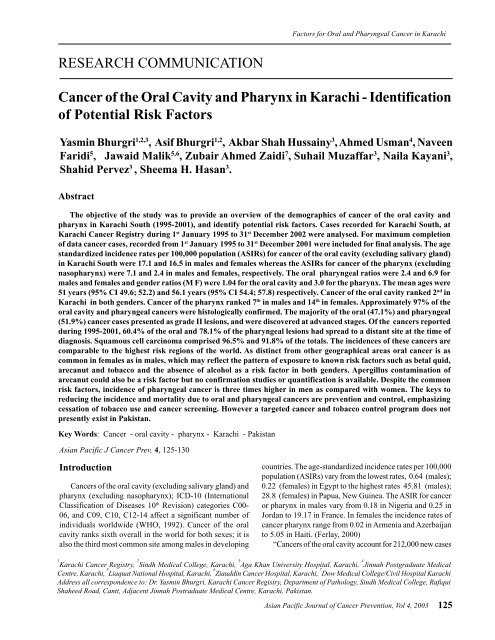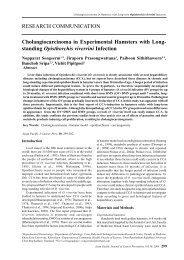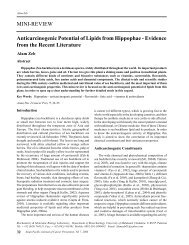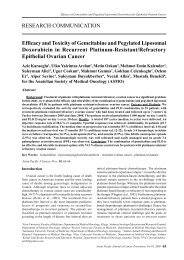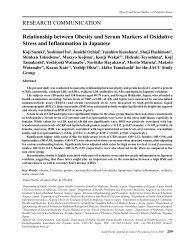Yasmin Bhurgri.pdf
Yasmin Bhurgri.pdf
Yasmin Bhurgri.pdf
- No tags were found...
You also want an ePaper? Increase the reach of your titles
YUMPU automatically turns print PDFs into web optimized ePapers that Google loves.
Factors for Oral and Pharyngeal Cancer in KarachiRESEARCH COMMUNICATIONCancer of the Oral Cavity and Pharynx in Karachi - Identificationof Potential Risk Factors<strong>Yasmin</strong> <strong>Bhurgri</strong> 1,2,3 , Asif <strong>Bhurgri</strong> 1,2 , Akbar Shah Hussainy 3 , Ahmed Usman 4 , NaveenFaridi 5 , Jawaid Malik 5,6 , Zubair Ahmed Zaidi 7 , Suhail Muzaffar 3 , Naila Kayani 3 ,Shahid Pervez 3 , Sheema H. Hasan 3 .AbstractThe objective of the study was to provide an overview of the demographics of cancer of the oral cavity andpharynx in Karachi South (1995-2001), and identify potential risk factors. Cases recorded for Karachi South, atKarachi Cancer Registry during 1 st January 1995 to 31 st December 2002 were analysed. For maximum completionof data cancer cases, recorded from 1 st January 1995 to 31 st December 2001 were included for final analysis. The agestandardized incidence rates per 100,000 population (ASIRs) for cancer of the oral cavity (excluding salivary gland)in Karachi South were 17.1 and 16.5 in males and females whereas the ASIRs for cancer of the pharynx (excludingnasopharynx) were 7.1 and 2.4 in males and females, respectively. The oral pharyngeal ratios were 2.4 and 6.9 formales and females and gender ratios (M F) were 1.04 for the oral cavity and 3.0 for the pharynx. The mean ages were51 years (95% CI 49.6; 52.2) and 56.1 years (95% CI 54.4; 57.8) respectively. Cancer of the oral cavity ranked 2 nd inKarachi in both genders. Cancer of the pharynx ranked 7 th in males and 14 th in females. Approximately 97% of theoral cavity and pharyngeal cancers were histologically confirmed. The majority of the oral (47.1%) and pharyngeal(51.9%) cancer cases presented as grade II lesions, and were discovered at advanced stages. Of the cancers reportedduring 1995-2001, 60.4% of the oral and 78.1% of the pharyngeal lesions had spread to a distant site at the time ofdiagnosis. Squamous cell carcinoma comprised 96.5% and 91.8% of the totals. The incidences of these cancers arecomparable to the highest risk regions of the world. As distinct from other geographical areas oral cancer is ascommon in females as in males, which may reflect the pattern of exposure to known risk factors such as betal quid,arecanut and tobacco and the absence of alcohol as a risk factor in both genders. Apergillus contamination ofarecanut could also be a risk factor but no confirmation studies or quantification is available. Despite the commonrisk factors, incidence of pharyngeal cancer is three times higher in men as compared with women. The keys toreducing the incidence and mortality due to oral and pharyngeal cancers are prevention and control, emphasizingcessation of tobacco use and cancer screening. However a targeted cancer and tobacco control program does notpresently exist in Pakistan.Key Words: Cancer - oral cavity - pharynx - Karachi - PakistanAsian Pacific J Cancer Prev, 4, 125-130IntroductionCancers of the oral cavity (excluding salivary gland) andpharynx (excluding nasopharynx); ICD-10 (InternationalClassification of Diseases 10 th Revision) categories C00-06, and C09, C10, C12-14 affect a significant number ofindividuals worldwide (WHO, 1992). Cancer of the oralcavity ranks sixth overall in the world for both sexes; it isalso the third most common site among males in developingcountries. The age-standardized incidence rates per 100,000population (ASIRs) vary from the lowest rates, 0.64 (males);0.22 (females) in Egypt to the highest rates 45.81 (males);28.8 (females) in Papua, New Guinea. The ASIR for canceror pharynx in males vary from 0.18 in Nigeria and 0.25 inJordan to 19.17 in France. In females the incidence rates ofcancer pharynx range from 0.02 in Armenia and Azerbaijanto 5.05 in Haiti. (Ferlay, 2000)“Cancers of the oral cavity account for 212,000 new cases1Karachi Cancer Registry, 2 Sindh Medical College, Karachi, 3 Aga Khan University Hospital, Karachi, 4 Jinnah Postgraduate MedicalCentre, Karachi, 5 Liaquat National Hospital, Karachi, 6 Ziauddin Cancer Hospital, Karachi, 7 Dow Medical College/Civil Hospital KarachiAddress all correspondence to: Dr. <strong>Yasmin</strong> <strong>Bhurgri</strong>, Karachi Cancer Registry, Department of Pathology, Sindh Medical College, RafiquiShaheed Road, Cantt, Adjacent Jinnah Postraduate Medical Centre, Karachi, Pakistan.Asian Pacific Journal of Cancer Prevention, Vol 4, 2003 125
<strong>Yasmin</strong> <strong>Bhurgri</strong> et alworldwide (2.2% of the total) followed by other pharyngealcancers with 94,000 cases (1.2%)”. (Parkin, 1998) Inindustrialized countries, men are affected two to three timesas often as women, largely due to higher use of alcohol andtobacco. Ethnicity strongly influences prevalence due tosocial and cultural practices, as well as socioeconomicdifferences. “The sex ratio (M:F) is 2.0 for oral cavity cancerand 4.4 for pharynx cancer. There are some similarities tothe geographic patterns for cancers of the oral cavity, andpharynx. In men, both are high in western and southernEurope, and south Asia, while oral cavity cancers (but notpharynx) have high rates in Melanesia, southern Africa, andAustralia/New Zealand”. (Parkin, 1998) The disease’sgeographical distribution may partly be explained by themajor risk factors, which are dietary or nutritionalcomposition, tobacco and alcohol. Betalquid and arecanutare additional risk factors in South Asia. Arecanut a knownrisk factor of submucus fibrosis has been implicated as anindependent risk factor for oral cancer. (Warnakulasuriya,2002)Pakistan, the seventh-most populous country in theworld, is a republic in south central Asia. It sharesinternational geographical boundaries and culturalsimilarities with India in the east and southeast, Iran andAfghanistan on the west and northwest and China and theSoviet Central Asian Republics in the north. This crossculturalheritage is reflected in the emerging patterns ofcancer in the country. Karachi is the largest city of Pakistan,capital of Sindh Province, located on the coast of ArabianSea (latitude: 24 -56’-00” and longitude: 67 -01’-00”). Thecity, also called Karachi Division is divided into 5 districts,South, Central, West, East and Malir. Karachi South (KS),the southern-most district has a population of 1,724,915 with929,394 (54%) males and 795,521 (46%) females. (Census1998) It includes all ethnicities of the country, namelySindhis, Punjabis, Pathans, Baluchs and Mohajirs with a fairrepresentation of all socio-economic categories. TheMohajirs are a mixed community, having migrated fromIndia at the time of partition of the sub-continent and largelyretaining their pre-migration cultural and social heritage. Inthe absence of a national cancer registration system, itqualifies as a sample population of the country. A profoundaffect of westernization is seen in parts of this district, instark contrast to an extreme cultural conservativeness insome parts and moderation in other parts of the same district.MethodologyIncident cancers of oral cavity and pharynx, diagnosedclinically or microscopically and registered at the KarachiCancer Registry during 1 st January 1995 to 31 st December2002 were analysed. For maximum completion of data,incident cases registered from 1 st January 1995 to 31 stDecember 2001 were included for final analysis. Theresidency status of oral cavity and pharynx cancer cases wasre-ascertained and rechecked. People residing in the specifiedgeographical regions for more than six months were126Asian Pacific Journal of Cancer Prevention, Vol 4, 2003considered residents. Variables recorded were the hospitalpatient-number, date of incidence, name, age, sex, address,ethnicity, topography, morphology, grading and staging.The data were classified using ICD-O2 (InternationalClassification of Diseases-Oncology, 2 nd edition) andcomputerized using a customized version of CANREG-3software provided by the International Agency for Researchon Cancer (IARC). (WHO, 1990) This software includesfacilities for the detection of duplicate registrations and forperforming internal checks on the validity of the entereddata. Both manual and computerized validity checks for thecancer data were performed as per recommendations ofIARC and International Association of Cancer Registries(IACR). This involved factors influencing comparability i.e.classification and coding. (Parkin, 1997; Parkin, 1994; Skeet,1991)The person-years of population at risk by sex and 5-yearage-groups were estimated based on the 1998 census (copyobtained from the Sindh Bureau of Statistics), assuming anannual growth rate of 1.74%. The growth rate was based onthe inter-census growth-rate and measures for inflow andoutflow of population, calculated by the Federal Bureau ofStatistics. Standardized incidence rate was calculated withan external reference population, the ‘world’ population witha given ‘standard’ age distribution. (Segi, 1960) ‘Thestandardized rate is the incidence rate that, theoretically,would have been observed if the population had a standardage distribution. The methodology applied was directstandardization, using 5-year age groups. The rates givenare the annual incidence per 100,000 population, averagedover the number of years for which data are presented’.(Parkin, 1997) Incidence tables were based on ICD-10.(WHO, 1992)ResultsThe ASIR for cancer of the oral cavity (excluding salivarygland) ICD-10 (International Classification of Diseases 10 thRevision) categories C00-06, in Karachi South was 17.1 and16.5 in males and females whereas the ASR for cancerpharynx (excluding nasopharynx) ICD-10 categories C09,C10, C12-14 was 7.1 and 2.4 in males and females. Thegender ratio (M:F) was 1.04 for oral cavity and 3.0 forpharynx. The mean ages were 51 years (95% CI 49.6; 52.2)and 56.1 years (95% CI 54.4; 57.8) for oral cavity andpharynx. (Tables 1,2)Cancer of oral cavity ranked 2 nd in Karachi with anidentical risk in both genders. Cancer of pharynx ranked 7 thin males and 14 th in females. The tumour ranking in maleswas lung, ICD-10 categories C33-C34 (ASIR 21.8), oralcavity ICD-10 categories C00-C06 (17.1), larynx ICD-10category C32 (9.9), urinary bladder ICD-10 category C67(9.6), lymphoma ICD-10 categories C81-C85; C96 (9.6/),prostate ICD-category C61 (7.5) and pharynx ICD-10categories C09, C10, C12-C14 (7.1).In females the ranking was breast ICD-10 category C50(ASIR 58.3), oral cavity ICD-10 categories C00-08 (17.5),
Factors for Oral and Pharyngeal Cancer in KarachiTable 1. Age-standardized Incidence Rate (ASIR), Basis of Diagnosis, Religion, and EthnicityOral cavity (N=1153) Pharynx (N=329) Oral/pharyngealASIR per 100,000 populationMales 17.1 7.1 2.4Females 16.5 2.4 6.9Gender ratio M/F 1.0 3.0Basis of Dignosis % %Clinical 2.3 3.7Histological 97.7 96.3ReligionMuslim 94.5 96.8 1.0Christian 1.7 0.9 1.9Hindus 1.8 1.8 1.0Parsees 0.7 0.5 1.4EthnicitySindhi 14.9 15.6 1.0Punjabi 11.9 9.8 1.2Pushtu 5.1 5.7 0.9Baluch 19.2 9.0 2.1Mohajir (urdu) 24.3 23.0 1.1Mohajir (gujrati) 10.8 10.7 1.0Mohajir (memon) 12.4 25.4 0.5Afghan migrants 1.4 0.8 2.3ovary ICD-10 category C56 (ASIR 9.8), cervix ICD-10category C53 (7.6), esophagus ICD-10 category C15 (7.6),lymphoma ICD-10 categories C81-85; C96 (7.0), uterusICD-10 categories C54-C55 (5.9), gall bladder ICD-10category C23 (5.4), colo-rectum ICD-10 categories C18-20(5.2), skin ICD-10 category C44 (5.0), thyroid ICD-10category C73 (3.9), liver ICD-10 category C22 (3.8), urinarybladder ICD-10 category C67 (3.2) and pharynx ICD-10categories C09, 10, 12-14 (2.4).Approximately 97% of the oral cavity and pharyngealcancers were histologically confirmed. The majority of theoral (47.1%) and pharyngeal (51.9%) cancer cases presentedas grade II lesions, and were discovered at advanced stages.60.4% of the oral and 78.1% of the pharyngeal cancersreported during 1995-2001 had spread to a distant site at theTable 2. Distribution of Cases According Grade, Extent,and Mean AgesOral cavity Pharynx(N=1153) (N=329)% %GradeI – mild 44.6 13.0II – moderate 47.1 51.9III – severe 7.8 33.3IV – undifferentiated 0.5 1.8ExtentIn-situ 0.4 1.2Localized 39.2 20.7Regional spread 56.5 73.2Distant spread 3.9 4.9Mean Ages 51 56.1time of diagnosis. (Table 2) Squamous cell carcinomacomprised 96.5% and 91.8% of the oral and pharyngealcancers. (Table 3). Border of the tongue and mucosa cheekcomprised approximately 80% of oral cancer lesions. (Table4)The race or ethnicity specific incidence rates were notcalculated as ethnicity specific population figures are yet tobe released by the census department. However the oralpharyngeal ratio for Baluchs (2.1) and Afghan migrants (2.3)was high and for Mohajir Memons (0.5), a group of migrantsfrom Mumbai, India was low (Table 1).Figure 1 a and b show the age specific incidence ratesfor cancer oral cavity and pharynx in the males and females.In the males the age specific rates for oral cancer showed agradual rise from 15 to 19 years of age to a maximum in the7 th decade, cancer pharynx showed a gradual rise from 30 to34 years of age to a maximum in the 8 th decade. In the femalesthe age specific rates for oral cancer showed a gradual riseTable 3. Distribution of Cases According to MorphologyOral cavity Pharynx(N=1153) (N=329)% %MorphologySquamouscell carcinoma 96.5 91.8Adenocarcinoma 0.3 0.5Other specified carcinomas 0.7 3.1Unspecified carcinomas 2.4 2.3Sarcoma - -Other specified morphology - 0.9Other unspecified morphology - 1.4Asian Pacific Journal of Cancer Prevention, Vol 4, 2003 127
<strong>Yasmin</strong> <strong>Bhurgri</strong> et alTable 4. Topographic Distribution of Cancer Cases OralCavityMales FemalesTopography % %Lip 4.9 2.4Tongue (base) 3.9 2.8Tongue (border) 24.8 32.6Gum 3.2 4.8Floor of mouth 0.7 0.7Palate 7.3 6.5Cheek (mucosa) 55.2 50.2from 10 to 14 years of age to a maximum in the 8 th decadewhereas the rates for cancer pharynx showed a gradual risefrom 20 to 24 years of age to a maximum in the 7 th decade.A flattening or an actual apparent decrease in the risk isseen in the 75+ age group for both cancer types and genders.DiscussionThe registry in Karachi South covers a stable population.The data has a good completion rate with adequate coverageof clinically diagnosed and death certified cases (Table 1).The percentage of cases reported with microscopicverification is high with values similar to developedcountries. Easily available and affordable biopsies andcytolologies have improved the microscopic verificationsand minimized under-registration of cases. Death registrationsystem in Karachi South is computerized and well organized.The registered data are valid. Collection from multiplereporting centres, regular scrutiny, re-abstracting andrecoding exercises and the use of CANREG-3 datamanagement software have enhanced the validity of the data.Checks for duplication of registered data, exclusion ofprevalent and non-resident cases are conducted manuallyand with CANREG-3 inbuilt check systems.Oral cancer is an important health issue. The WHOpredicts a continuing worldwide increase in the number ofpatients with oral cancer, extending this trend well into thenext several decades. (Sciubba, 2001) Significant agentsinvolved in the etiology of oral cancer in Western countriesinclude sunlight exposure, smoking and alcoholconsumption. In developing countries tobacco, alcohol, betalquid chewing, together with poor diet are the most important100a) MalesAge-specific rates/100,0001010.15 to 910 to1415 to1920 to2425 to2930 to3435 to3940 to4445 to4950 to5455 to5960 to6465 to6970 to7475+Oral cavity - - 0.4 0.7 3.7 10 18.2 25.6 27.8 35.3 51.8 79. 2 92.5 68.9 47.6Pharynx - - - - - 1.1 1.7 5 8.9 20.6 36.1 48 59 68.1 30.91000 Age Specific Incidence Rates (females)Age (years)b) FemalesAge-specific rates/100,0001001010.110 to1415 to1920 to2425 to2930 to3435 to3940 to4445 to4950 to5455 to5960 to6465 to6970 to7475+Oral cavity 0.2 0.2 0.9 3.3 7.1 10. 1 18.6 25.8 46.5 56.4 80.7 137.8 147.8 58.7Pharynx - - 0.3 0.6 1.5 2 2.4 3.5 6.1 8.4 10.9 11.8 12.2 7.7Age (years)Oral cavityPharynxFigure 1. Cancer of Oral Cavity and Pharynx, Age Specific Incidence Rates a) Males; b) Females128Asian Pacific Journal of Cancer Prevention, Vol 4, 2003
Factors for Oral and Pharyngeal Cancer in Karachirisk factors for cancers of the oral cavity and pharynx thoughseveral less important risk factors have also been associated.There is a strong evidence for an etiological relationshipwith human papilloma virus. Other etiologic factorsassociated with oral squamous cell carcinoma, but far lesssignificant statistically, include syphilis, sideropenicdysphagia, low educational attainment, occupation as afarmer or manual worker and various indicators of poor oralhygiene. (Sciubba, 2001; Franceschi, 2000; Parkin, 1998)The habit of betal chewing is of great antiquity, tobaccobeing added sixteenth century onwards. (Muir and Zaridze,1986) The basic quid comprises the leaf of betal vine (Piperbetle), sliced or shaved arecanut from the betal palm (Arecacatechu), slaked lime paste and catechu paste. Paan masalaa later addition to this family is a powdery mixture of betelnut, lime and arecanut (supari) in various proportions.Tobacco may be a component of some variants of paanmasala. This ‘smokeless tobacco use’ has been widelypublicized in the carcinogenesis of oral cancer in individualsof South-Asian origin. Case-control studies in India haveattributed a combination of smoking, alcohol drinking, paantobaccochewing and poor oral hygiene to oral cancer.(Balaram, 2002; Dhar, 2000) The incidence in Karachi(District South) is identical to the high risk geographicalzones of India, indicating that cultural and lifestylecharacteristics retained by the migrants as the majordeterminants of the disease.In Karachi more than 70% of members of both genderschew paan masala; this includes school children as youngas 3-4 years of age. 36% of the females and 44% of themales in Karachi chew paan with or without tobacco. (Alam,1998; Merchant, 1998) These figures correspond well withthe incidence of oral cancer. As in several other regions ofthe sub-continent, arecanut use has been indicated as anindependent risk factor for oral cavity cancer, and probablyfor the pharyngeal cancers, however there is no reliable studyto confirm this co-relation for Pakistan. In Karachi identicalrisk factors are seen for oral cancer in both genders, whereasfor pharynx (excuding nasopharynx), the risk factor in malesis thrice that of the females. A lower oral/pharyngeal ratioin men compared to women, is observed globally.(Franceschi, 2000) The most important single risk factorfor development of these cancers appears to be tobacco use.All forms of tobacco in use are considered major risk factorseg cigarette and bidi smoking, snuff or naswar. Alcohol isnot a confounder in this Muslim country. In the developedcountries, alcohol synergizes with tobacco as a risk factorfor all upper aerodigestive tract cancers, this is supermultiplicativefor the mouth.A trend towards higher prevalence of oral cancer isobserved in Karachi and no progress has been achievedconcerning cancer control during the last few decades.Despite the simplicity of the oral examination, cytologicaland histopathological verifications, most of oral cancers arediscovered at advanced stages bearing severe prognosis.Most of the patients sought medical care in the first year;however more than half of them had lesions in stage T3 andT4.(Table 2) The keys to reducing mortality are preventionand control, emphasizing cessation of tobacco use and cancerscreening. The earlier any intraoral or extraoral abnormalitiesor lesions are detected and biopsied, more lives can be saved.Though controversy exists whether screening programseffectively reduce the mortality rate, it is largely believedthat the protection offered by screening persisted up to 3years since the last test. (Sankaranarayanan, 2002) Improvedawareness of both the attendant medical team and the targetpopulation may improve the chances of preventionThere is an increasing incidence of oral cancer in theyounger persons. The reasons are unclear. It has beenhypothesised either to be a result of an increase in exposureto known risk factors amongst certain groups in thecommunity, or to be due to new aetiological agents. A surveyof young persons with oral cancer suggest that most areexposed to traditional risk factors of tobacco smoking,drinking alcohol and a low consumption of fruit andvegetables. (Mackenzie, 2000) The chewing habit is sodeeply ingrained in the Indian culture that a high prevalenceof arecanut chewing is seen amongst children (secondgeneration) of South Asian origin living in UK and Australia(Farrand, 2001; Cox, 2000).Most sporadic tumors are the result of a multi-stepprocess of accumulated genetic alterations. These alterationsaffect epithelial cell behavior by way of loss of chromosomalheterozygosity, which in turn leads to a series of eventsprogressing to the ultimate stage of invasive squamous cellcarcinoma. (Sciubba, 2001) Alterations in p53 tumoursuppressor gene and its expression; GSTM1 null genotype,homozygous deletion of the GSTM1 gene are all implicatedin the pathogenesis of betel quid and tobacco-related oralcancer. The risk increases further when these individualsare exposed to environmental toxicants such as chemicalsin cigarette smoke, alcohol, and betel quid. (Buch, 2002;Kietthubthew, 2001) Human papilloma virus types and itsassociation with P53 codon 72 polymorphism in tobaccoaddicted oral squamous cell carcinoma (OSCC) patients hasalso been observed in Eastern India. (Nagpal, 2002)Deficient CYP2A6 activity due to genetic polymorphismreduces oral cancer risk in betel quid chewers. (Topcu, 2002)Regular consumption of green tea is also consideredbeneficial in the prevention of oral cancer, in individualsthat ingest alcohol in combination with the use of tobaccoproducts. The mechanism involving a p57 mediated survivalpathway. (Hsu, 2002)Oral and oropharyngeal cancers represent 3% of allcancers in the United States annually, with nearly 50% ofpeople diagnosed with oral and oropharyngeal cancers dyingas a result of the disease. (Weinberg, 2002; Sciubba, 2000)There was little change in early detection of oral cancer orin 5-year relative survival rates between 1973-84 and 1985-96 in nine SEER regions. (Shiboski, 2000) Sixty percent oforal cancers are well advanced by the time they are detected,even though physicians and dentists frequently examine theoral cavity. Because the dental practitioner is in an idealposition for recognizing any abnormality of the oral mucosa,Asian Pacific Journal of Cancer Prevention, Vol 4, 2003 129
<strong>Yasmin</strong> <strong>Bhurgri</strong> et alhe or she is involved in the battle against oral cancer byhelping establish the diagnosis at an early stage. (Sciubba,2000) This suggests a deficiency in professional and publiceducation regarding early diagnosis of oral cancer.ConclusionThe demographic, site, stage, and histologic dataavailable for this large number of cases at the Karachi CancerRegistry allowed an accurate characterization of thecontemporary status of oral cancer in the Karachi. Theincidence of cancer oral cavity and pharynx in Karachi iscomparable to high incidence regions of the world. Asdistinct from other geographical areas oral cancer is ascommon in females as in males, which may reflect the patternof exposure to known risk factors such as betal quid, arecanutand tobacco and the absence of alcohol as a risk factor inboth genders. Aspergillus contamination of arecanut couldalso be a risk factor but no confirmation studies orquantification is available. Despite the common risk factorsincidence of pharyngeal cancer is three times higher in menas compared with women. Further research needs to befocused on the etiological aspects of these cancers. The keysto reducing the incidence and mortality due to oral andpharyngeal cancers are prevention and control, emphasizingcessation of tobacco use and cancer screening. A targetedcancer and tobacco control program is presently non-existentin Pakistan.ReferencesAlam SE (1998). Prevalence and pattern of smoking in Pakistan. JPak Med Assoc, 48, 64-6.Balaram P, Sridhar H, Rajkumar T, et al (2002). Oral cancer insouthern India: the influence of smoking, drinking, paanchewingand oral hygiene. Int J Cancer, 98, 440-5.Boucher BJ (2001). Paan without tobacco: an independent riskfactor for oral cancer. Int J Cancer, 91, 592-3.Buch SC, Notani PN, Bhisey RA (2002). Polymorphism at GSTM1,GSTM3 and GSTT1 gene loci and susceptibility to oral cancerin an Indian population. Carcinogenesis, 23, 803-7.Census Bulletin-1 (1998). Population and Housing Census ofPakistan, Population Census Organisation Statistics division,Federal Bureau of Statistics, Government of Pakistan.Cox S (2000). Oral cancer in Australia-risk factors and diseasedistribution. Ann R Australas Coll Dent Surg, 15, 261-3.Dhar PK, Rao TR, Sreekumaran-Nair N, et al (2000). Identificationof risk factors for specific subsites within the oral andoropharyngeal region - a study of 647 cancer patients. IndianJ Cancer, 37, 114-22.Farrand P, Rowe RM, Johnston A, Murdoch H (2001). Prevalence,age of onset and demographic relationships of different arecanuthabits amongst children in Tower Hamlets, London. Br DentJ, 190, 150-4.Ferlay J, Bray F, Pisani P, Parkin DM (2001). Globocan 2000:Cancer Incidence, Mortality and Prevalence Worldwide,130Asian Pacific Journal of Cancer Prevention, Vol 4, 2003Version 1.0. IARC Cancer Base No. 5, Lyon.Franceschi S, Bidoli E, Herrero R, Munoz N (2000). Comparisonof cancers of the oral cavity and pharynx worldwide: etiologicalclues. Oral-Oncol, 36, 106-15.Hsu Stephen D, Singh Baldev B, Lewis Jill B, et al (2002).Chemoprevention of oral cancer by green tea. Gen Dent, 50,140-6.Kietthubthew S, Sriplung H, Au WW (2001). Genetic andenvironmental interactions on oral cancer in Southern Thailand.Environ Mol Mutagen, 37, 111-6.Mackenzie J, Ah-See K, Thakker N, et al (2000). Increasingincidence of oral cancer amongst young persons: what is theaetiology? Oral Oncol, 36, 387-9.Merchant AT, Luby SP, Perveen G (1998). Smoking in Pakistan:more than cancer and heart disease. J Pak Med Assoc, 43, 77-9.Muir CS and Zaridaze DG (1986). Smokeless Tobacco and Cancer:an overview. In Tobacco a Major International Health HazardZaridze DG and Peto R. (eds) pp35-44 IARC ScientificPublications No.74, LyonNagpal JK, Patnaik S, Das BR (2002). Prevalence of high-riskhuman papilloma virus types and its association with P53 codon72 polymorphism in tobacco addicted oral squamous cellcarcinoma (OSCC) patients of Eastern India. Int J Cancer, 97,649-53.Parkin DM (1998). The Global Burden of Cancer. Cancer Biology8, 219-35.Parkin DM, Chen VW and Ferley J (eds.) (1994). Comparabilityand Quality Control in Cancer Registration, IARC TechnicalReport No.19, Lyon.Parkin DM, Whelan SL, Ferley J, Raymond L, Young J (eds.)(1997). Cancer Incidence in the Five Continents Volume VII,IARC Technical Report No.143, Lyon.Sankaranarayanan R, Fernandez-Garrote L, Lence-Anta J, PisaniP, Rodriguez-Salva A (2002). Visual inspection in oral cancerscreening in Cuba: a case-control study. Oral Oncol, 38, 131-6.Sciubba JJ (2000). Oral precancer and cancer: etiology, clinicalpresentation, diagnosis and management. Compend ContinEduc Dent, 21, 892-8.Sciubba JJ (2001). Oral cancer. The importance of early diagnosisand treatment. Am J Clin Dermatol, 2, 239-51.Segi M (1960). Cancer Mortality in Selected Sites -in 24 Countries(1950-57), Sendai, Tohoku University School of Public Health.Shiboski CH, Shiboski SC, Silverman S Jr (2000). Trends in oralcancer rates in the United States, 1973-1996. Community DentOral Epidemiol, 28, 249-56.Skeet RC (1991). Comparability and Quality Control. In CancerRegistration: Principles and Methods, Jensen OM, Parkin DM,MacLennan R, Muir CS and Skeet RG (eds); IARC ScientificPublications No. 95, Lyon.Topcu Zeki, Chiba Itsuo, Fujieda Masaki, et al (2002). CYP2A6gene deletion reduces oral cancer risk in betel quid chewers inSri Lanka. Carcinogenesis, 23, 595-8.Warnakulasuriya S, Trivedy C, Peters TJ (2002). Arecanut use: anindependent risk factor for oral cancer. BMJ, 324, 799-800.WHO (1990). International Classification of Diseases for Oncology,Ed. 2, Geneva, World Health Organisation.WHO (1992). International Statistical Classification of Diseasesand Health Related Problems 10 th Revision, Geneva, WorldHealth Organisation.Weinberg Mea A, Estefan Denise J (2002). Assessing oralmalignancies. Am Fam Physician, 65, 1379-84.


